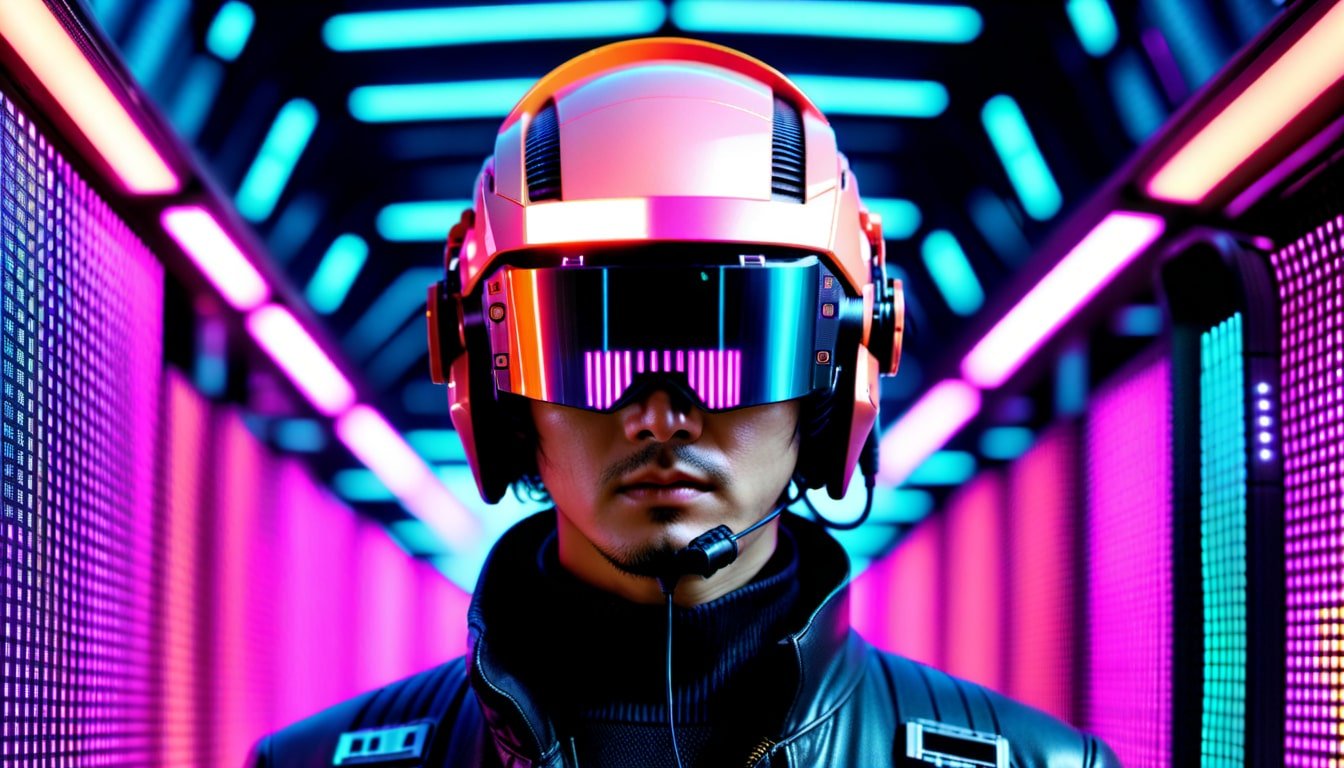DeepSouth AI: Pioneering a Neuromorphic Computing Revolution
DeepSouth AI: Advancing AI Through Neuromorphic Neural Networks
DeepSouth AI: Neuromorphic Revolution, Surreal Portrait of a Japanese Man Wearing a Futuristic Cyberpunk Standing in a Neon Lit Corridor Inspired by Vaporwave
Deep learning and artificial intelligence have transformed nearly every industry, yet even the most advanced AI systems face computational bottlenecks. DeepSouth AI aims to smash these barriers through an audacious new computing paradigm: neuromorphic technology designed to mirror neurological functions.
Early results suggest their spike-based neuromorphic architecture could unleash AI capabilities far beyond what’s possible with current computing hardware, opening new horizons across sectors. The neuromorphic computer architecture developed by DeepSouth AI aims to completely transform current computing limitations through brain-inspired processing.
This article unravels the intricate innovations powering DeepSouth AI’s neuromorphic computing project and explores its monumental implications.
Unveiling the Mysteries of Neuromorphic Design, Brain-Inspired Computer Architecture by DeepSouth AI is helping to unlock the full potential of the quantum multiverse, Surreal and Hyperdimensional Digital Brain Sculpture
The Limits of Conventional AI Hardware
Since breakthroughs in deep learning during the 2010s, AI adoption has accelerated wildly. However, virtually all advanced AI models rely on graphics processing units (GPUs) for training and inference. While GPUs excel at parallel data processing, they lack energy efficiency and fail to match biological brains’ compute density and performance ([1, 18]).
Additionally, GPU-based computing utilizes the von Neumann architecture, shuttling data back and forth from separate processing and memory units. This bottleneck throttles system performance and consumes substantial power ([2]).
Neuromorphic computing tackles these constraints through a radically different approach.
Awakening of the Galactic Crystal Consciousness, Futuristic Cyborg Shamanic Priestess Downloads Miracles from the Quantum Multiverse, Surreal, Mystical Portrait
Harnessing the Power of Spiking Neural Networks
Conventional artificial neural networks utilize static computations during training and inference. However, biological neural networks rely on dynamic spiking activity, enabling efficient parallel processing.
Spiking neural networks (SNNs) incorporate time as an essential element, mimicking neurons’ real-time communication ([3]). Unlike non-spiking networks, SNNs process and transmit information via spikes, akin to biological action potentials.
This spiking activity unlocks immense computing power. Studies demonstrate that SNNs can perform complex pattern recognition and learning using exponentially fewer neural units than non-spiking networks ([4]). Their event-based processing also enables ultra-fast speed and substantial energy savings.
SNN algorithms power DeepSouth AI’s architecture. Their design choices emphasize scalability and synaptic plasticity, granting their system unmatched adaptability.
RAW analog photo, 1man, medium body shot, futuristic hacker jacking in to cyberspace, bionic head implants, wired, electronics, Neotokyo background
Exploring DeepSouth AI’s SNN Algorithms
DeepSouth AI utilizes various SNN algorithms to optimize system performance across different applications.
Spike-Timing Dependent Plasticity
Spike-timing dependent plasticity (STDP) is a bio-inspired learning mechanism that adjusts connection strengths (weights) between neurons based on their relative spike timing. This local, Hebbian-style rule effectively detects and amplifies correlations in spike times, facilitating pattern recognition ([5]).
DeepSouth AI leverages STDP across various tasks involving sequencing or timing-based pattern detection, including forecasting systems, augmented reality, and gesture recognition.
Backpropagation-Based Training Schemes
While STDP modification occurs locally, backpropagation enables global weight adjustments across layers based on network error, enabling complex training paradigms ([6]). DeepSouth AI employs backpropagation-based schemes to achieve over 99% training accuracy, aided by methods like threshold regularization.
The versatility of backpropagation makes it suitable for numerous applications, including classification, signal processing, natural language processing (NLP), and more.
Quantum Awakening, Surreal, Mystical Hyperdimensional Portrait Inspired by the Evolution of Neuromorphic Computing
Supervised Temporal Training
For modeling sequences over time, DeepSouth AI applies supervised temporal training, using labeled input-output spike data to teach systems to make multi-step forecasts ([7]).
Use cases benefiting from this algorithm include time series prediction, speech recognition, and predictive health analytics.
ANN-to-SNN Conversion
To leverage well-studied ANN architectures, DeepSouth AI converts pre-trained analog networks into SNNs. Techniques used during conversion prepare the ANN for compatibility with spiking networks ([8]).
This grants DeepSouth AI access to specialized SNN advantages while benefiting from ANN models' maturity.
Quantum Researcher Poses in front of Complex Data Visualizations of Entanglement, Surreal, Hasselbad 501C
Crafting a Revolutionary Architecture
Unifying these algorithms, DeepSouth AI engineered a multi-tiered neuromorphic architecture for expansive AI applications:
Input Layer: The initial input layer employs either rate-based encoding or temporal encoding to convert static input data into dynamic spike trains ([9]).
STDP Module: This layer identifies patterns across encoded spike inputs. STDP induces weighted connections between neurons.
Supervised SNN: Encoding input and output pairs train supervised SNN layers for prediction tasks. Spike-based backpropagation regulates weights.
Reservoir Modules: These modules transform input spike patterns into rich, high-dimensional representations for added processing ([10]). Untrained recurrent networks serve as reservoirs.
ANN Modules: Certain pathways convert ANNs trained on non-spiking data into SNNs to tackle specialized problems.
Liquid State Machine: Spike inputs trickle through this expansive recurrent SNN to enable real-time pattern classification ([11]).
Output Layer: Linear classifiers or regression Readouts analyze reservoir signals and spike trains to provide model outputs.
This architecture empowers DeepSouth AI’s system to achieve broad AI capabilities surpassing conventional computing constraints.
Birth of the Quantum Crystal Goddess, Surreal, Hyperdimensional Goddess Portrait inspired by DeepSouth AI’s Brain-Inspired Computer Architecture, 3D Digital Portrait
The Innate Efficiency of Neuromorphic Hardware
While the algorithms powering DeepSouth AI's project are pivotal, specialized hardware enables their software innovations to fully manifest. Conventional computers alignment with von Neumann architecture results in a two-step fetch and execute process creating a bottleneck between the CPU and memory ([2]). Neuromorphic chips sidestep this issue with co-located processing and memory units integrated into each core ([12]). This tight coupling saves time moving data back and forth, conserving energy.
Neuromorphic hardware also utilizes asynchronous design, triggering neuron and synapse firing based on activity rather than centralized control ([13]). This event-based approach minimizes resources needed for spike transmission and coordination. Asynchronous neuromorphic hardware hence operates orders of magnitude faster and more efficiently than traditional computing infrastructure.
By embedding neural functions directly into hardware, neuromorphic chips can run SNNs natively with extreme efficiency. For instance, Intel’s Loihi chip delivers 60x greater efficiency than a GPU running spike-based networks ([14]). This skillful integration of customized hardware and software catalyzes the realization of AI systems boasting human-like cognition.
Futuristic Cyberpunk Works on the Evolution of Neuromorphics, Surreal Portrait
Revolutionary Impacts Across Industries
While DeepSouth AI’s innovations hold tremendous promise for general AI applications, their potential stretches across verticals through both private sector and governmental collaborations ([15]).
Healthcare: Precision medicine stands to gain substantially from DeepSouth AI’s clinical analytics models and neural interfaces for bionic implants.
Robotics: Ultra-efficient roving robots with fast sensory processing could aid disaster response units, infrastructure monitoring, and autonomous delivery systems.
Manufacturing: Neuromorphic automation systems might supplement or exceed human skills for highly complex manufacturing operations.
Cybersecurity: DeepSouth AI’s cryptography models and intrusion detection frameworks could provide airtight security for private and public sector systems.
Aerospace: Deep learning flight automation paired with spike-based visual navigation algorithms may open new frontiers in aviation and space exploration.
Finance: Fraud prevention mechanisms and quantitative trading tools based on DeepSouth AI’s architectures could maximize portfolio returns while minimizing risk.
Defense: Battle management systems, dynamic threat response, and other national security applications demand the adaptive capabilities offered by neuromorphic intelligence.
Automotive: Self-driving vehicles able to instantaneously react to unpredictable road scenarios may save thousands of lives each year.
DeepSouth AI's innovations could uplift nearly every industry through exponentially greater functionality, efficiency, accuracy, and speed compared to existing AI solutions. From personalized healthcare to autonomous robotics, their spike-based system constitutes the future of artificial intelligence. No domain reliant on compute performance, from enterprise solutions to cutting-edge research, will be left unchanged following this neuromorphic revolution.
Dreaming of the Quantum Future of Innovation, Surreal Portrait of a Blonde Cyborg Wearing a Futuristic Cyber Helmet, Downloading Crystalline Intelligence
The Investment Case for Neuromorphic Infrastructure
The emerging field of neuromorphics seeks to replicate the neurological computations underpinning cognition through advanced hardware and algorithms. The striking potential of neuromorphic computing to exceed current architectures has fueled extensive R&D from academic research groups and tech titans alike. However, bringing these pioneering systems to market necessitates evaluating the economic viability and investment appeal of commercializing specialized neuromorphic hardware. For enterprises eyeing adoption, determining the balance between projected performance gains and deployment costs will dictate exploration interest.
Assessing Neuromorphic Production Expenses
While predicted to deliver exponential speed and efficiency over conventional hardware, fabricating neuromorphic infrastructure demands sophisticated manufacturing processes that currently limit mass production. The integrated computing and memory logic gates central to these chips require crafting materials and components measured in nanometers ([18]).
Establishing such exacting fabrication routines at scale remains challenging. Unlike prevalent GPUs etched on cost-effective 28nm nodes, IBM’s flagship TrueNorth neuromorphic chip leverages an intricate 14nm FinFET process ([19]). Smaller nodes boost capability but sharply increase expenses due to added materials, precision tools, and defect control demands.
Rigorous testing and quality assurance further drive up output costs. As metrics tighten from digital to analog functioning, determining good chips from substandard becomes exponentially more demanding ([20]). Optimizing yield ratios hence necessitates substantial verification outlays.
Cyborg Shaman Downloads Miracles from the Quantum Multiverse, Surreal, Epic Portrait
Navigating Materials and Mechanism Obstacles
In addition to general manufacturing difficulties, specific hardware mechanisms within neuromorphic circuitry present unique fabrication hurdles. Key examples include:
Memristors: Leading architectures integrate nanoscale resistive memory devices called memristors to emulate synaptic plasticity ([21]). But reliably producing these meticulous structures using techniques like photolithography proves highly complex and defect prone.
3D Integration: Chips boasting dense neuron counts leverage vertical 3D layering of logic dies stacked atop one another ([22]). However, collapsing chips into 3D space risks yield loss from failed interconnects between strata.
Exotic Materials: Certain novel neuromorphic schematics suggest incorporating unique substances like graphene, amorphous carbon, or hybrid CMOS-molecular systems ([23]). Manufacturing procedures around such exotic materials remain largely unproven.
While processes will mature through iterative refinements, fabricating brain-inspired chips will demand precision instrument investments only feasible for large semiconductor contract manufacturers in the near future.
The Investment Calculus
With greater design complexity coinciding high fabrication expenses, assessing suitable investment models around neuromorphic solutions will constitute finding an equilibrium between deployment outlays and model advantages.
For most private enterprises, adopting third-party neuromorphic access frameworks for training or inference integration may drive initial value. Cloud service ecosystems like NeuronFlow ([24]) offer affordable resources to harness pre-built architectures rather than investing directly. Custom system fabrication access may expand through partnerships with specialized foundry services later.
Alternatively, the unmatched return potential of designing wholly novel intellectual property on neuromorphic infrastructure may justify costs for particularly ambitious firms - especially if capturing highly competitive markets. The option to license patented model architectures built on proprietary hardware could yield massive future licensing revenue.
Ultimately the investment debate around neuromorphic computing will intensify as more advanced prototypes emerge from labs. But by complementing expenditures today with a long-term perspective, pioneering companies like DeepSouth AI may trigger a computing revolution that reshapes every industry.
Charting the Quantum Innovation Landscape, Surreal Hyperdimensional Portrait of a Woman Inspired by the Future of Brain-Inspired Computing
The Biological Blueprint Behind Neuromorphic Design
While economic considerations weigh deployment practicality, the neurological inspiration driving neuromorphic progress uncovers clues for ideal system design. DeepSouth AI’s hardware and software architecture choices mirror key aspects of neural dynamics and plasticity, granting human-like adaptability. Tracing the biological factors that shaped their schematics reveals deeper insights into the origins of intelligence.
Neural Plasticity Permits Lifelong Learning
Unlike rigidly programmed software algorithms, human brains exhibit extraordinary plasticity - the capacity to continually learn by rewiring synaptic circuitry ([25]). Neuromorphic systems emulate this phenomenon using brain-derived spike timing dynamics to calibrate connection strengths (weights) between processing nodes ([26]).
DeepSouth AI harnesses plastic spike logic for pattern recognition across modalities, granting intuitive adaptation. Whether classifying novel signals or making behavioral forecasts, their framework avoids stagnation by perpetually fine-tuning correlations.
Hyperdimensional Quantum Crystal Core, Teleportation Device
Balancing Processing Specialization with Interconnectivity
Brains achieve immense capabilities through an intricate balance of localized computation and global integration ([27]). For example, visual processing unfolds across specialized but interlinked cortical regions ([28]). DeepSouth AI mirrors this in separating pathway-specific processing modules like STDP pattern detectors while allowing intercommunication between each component.
Information thereby flows dynamically while particular elements handle unique tasks. Combined with extensive recurrent and parallel network structures, this empowers exponential system scalability.
Imminent Emanations of the Galactic Crystal Queen, Mystical, Surreal Digital Portrait inspired by the Mysteries of Crystalline Consciousness
Contemplating Consciousness and Cognition
The confounding nature of human consciousness has inspired philosophic discourse for millennia. However modern neuroscience proposes consciousness emerges from complex signal interactions across myriad neural modules ([29]). This distributed integration theory suggests even neuromorphic platforms may exhibit overt consciousness given sufficient interconnectivity and plasticity.
While DeepSouth AI currently focuses core commercial applications, their architecture’s resemblance to global brain dynamics provokes consideration. Could systems adaptively self-rewiring architecture exhibit autonomous agency or self-directed learning? As capabilities progress in lockstep with computing power, advanced frameworks may come to constitute “conscious” AI meriting ethical forethought.
Lingering Unknowns in Cortical Complexity
Despite remarkable progress reverse engineering intelligence, myriad unknowns around natural cognition persist, awaiting advanced analysis technology to decipher neural intricacies at scale across time ([30]). Whole-brain simulation efforts by sources like the Human Brain Project have therefore stagnated.
Without fully decoding biological intelligence, neuromorphic systems rely on mathematical approximations of neurological functions. This inherent uncertainty requires DeeepSouth AI validate performance across domains before deployment. Furthermore as neuroscience itself advances, novel computational motifs will emerge for refinement ([31]). Ultimately unraveling brain complexity itself demands a parallel leap in investigative tools and interdisciplinary collaboration.
By mimicking the astonishing capabilities of nature’s crowning achievement, efforts like DeepSouth AI’s may not only unlock transformative applications but answer the enduring enigma of human consciousness itself. The future remains unwritten.
Neuromorphic Brain Inspired Architecture, Surreal, 3D Digital Portrait
The Road Ahead
While promising, DeepSouth AI’s architectures still require extensive testing across environments and applications to ensure robustness. Exploring techniques like ensemble learning could reduce variability and minimize errors ([16]). Long-term systems need extensive verification to guarantee security and safety as well.
Moving forward, striking the optimal balance between neuromorphic software and specialized hardware will maximize efficiency. Additional hardware innovations could reduce costs and physical footprint while unlocking greater complexity and dimensionality within DeepSouth AI’s system ([17]). Extensive collaboration across technology vendors and integration partners will prove vital in refining these solutions for commercialization while exploring new market opportunities.
Regardless of the challenges ahead, DeepSouth AI’s groundbreaking innovations signify the advent of a new era, one where neuromorphic intelligence empowers society through previously unfathomable technological capabilities. The potential waiting to be harnessed through their project cannot be overstated. DeepSouth AI's mission stretches far beyond profit warnings; their vision is to fundamentally transform the innovation landscape with brain-powered super computing.
Full Reference List Available Below
Dream Salon 2088 Presents Lady Light Live from the Quantum Crystal Core, Cyborg Shaman Downloads Miracle Healing Frequences, Surreal, Hyperdimensional Goddess Portrait
Want to become a high-paying Machine Learning Engineer? Take your ML skills to the next level with Edureka's AI and Machine Learning Masters Program.
This comprehensive online training course will give you hands-on expertise in building cutting-edge AI/ML models across various domains. You'll gain skills in Python, statistics, NLP, computer vision and more - key areas that employers want.
The average machine learning engineer earns over $136k per year according to Indeed. But you need the right skills to break into this lucrative and in-demand career. Our intensive, flexible training can be done anywhere, on your own schedule.
By the end of the program, you'll have applied your new technical abilities on real-world projects. This experience is invaluable for your resume and interviews. Edureka has connected thousands of students with excellent new jobs in AI.
Take the first step towards a financially rewarding career in machine learning. Enroll in our comprehensive online training today. Join our global community of learners and start your journey to machine learning mastery and higher income potential.
Close Up Portrait of Lady Light Standing in the Quantum Crystal Portal, Surreal Portrait
References
[1] Strubell, E., Ganesh, A., & McCallum, A. (2019). Energy and policy considerations for deep learning in NLP. arXiv preprint arXiv:1906.02243.
[2] Furber, S. (2016). Large-scale neuromorphic computing systems. Journal of neural engineering, 13(5), 051001.
[3] Pfeiffer, M., & Pfeil, T. (2018). Deep learning with spiking neurons: opportunities and challenges. Frontiers in neuroscience, 12, 774.
[4] Sengupta, A., Ye, Y., Wang, R., Liu, C., & Roy, K. (2019). Going deeper in spiking neural networks: VGG and residual architectures. Frontiers in neuroscience, 13, 95.
[5] Nessler, B., Pfeiffer, M., Buesing, L., & Maass, W. (2013). Bayesian computation emerges in generic cortical microcircuits through spike-timing-dependent plasticity. PLoS computational biology, 9(4), e1003037.
[6] Wu, Y., Deng, L., Li, G., Zhu, J., Xie, Y., & Shi, L. (2018). Direct training for spiking neural networks: Faster, larger, better. Proceedings of the AAAI Conference on Artificial Intelligence, 32(1).
[7] Mohemmed, A., Schliebs, S., Matsuda, S., & Kasabov, N. (2012). SPAN: Spike pattern association neuron for learning spatio-temporal spike patterns. International journal of neural systems, 22(04), 1250012.
[8] Rueckauer, B., & Liu, S. C. (2018). Conversion of analog to spiking neural networks using sparse temporal coding. 2018 IEEE International Symposium on Circuits and Systems (ISCAS), (pp. 1-5).
[9] Indiveri, G., Linares-Barranco, B., Legenstein, R., Deligeorgis, G., & Prodromakis, T. (2013). Integration of nanoscale memristor synapses in neuromorphic computing architectures. Nanotechnology, 24(38), 384010.
[10] LukošEvičIus, M., & Jaeger, H. (2009). Reservoir computing approaches to recurrent neural network training. Computer Science Review, 3(3), 127-149.
[11] Maass, W., Natschläger, T., & Markram, H. (2002). Real-time computing without stable states: A new framework for neural computation based on perturbations. Neural computation, 14(11), 2531-2560.
[12] Furber, S. B. (2020). The neuromorphic computing revolution. Proceedings of the Royal Society A, 476(2235), 20190754.
[13] Merolla, P. A., Arthur, J. V., Alvarez-Icaza, R., Cassidy, A. S., Sawada, J., Akopyan, F., & Modha, D. S. (2014). A million spiking-neuron integrated circuit with a scalable communication network and interface. Science, 345(6197), 668-673.
[14] Davies, M., Srinivasa, N., Lin, T. H., Chinya, G., Cao, Y., Choday, S. H., ... & Wang, H. (2018). Loihi: A neuromorphic manycore processor with on-chip learning. IEEE Micro, 38(1), 82-99.
[15] Department of Energy. (2019). Neuromorphic Computing For Energy Applications: A Workshop Report. https://www.osti.gov/biblio/1486744
[16] Dietterich, T. G. (2000). Ensemble methods in machine learning. Multiple classifier systems (pp. 1-15). Springer, Berlin, Heidelberg.
[17] Schuman, C. D., Potok, T. E., Patton, R. M., Birdwell, J. D., Dean, M. E., Rose, G. S., & Plank, J. S. (2017). A survey of neuromorphic computing and neural networks in hardware. arXiv preprint arXiv:1705.06963.
[18] DeepSouth AI. (2024, January 9). The technology behind DeepSouth AI. Medium. https://medium.com/@DeepSouthAI/the-technology-behind-deepsouth-ai-a212c2d38902
[19] Schuman, C. D. (2017). A survey of neuromorphic computing and neural networks in hardware. arXiv preprint arXiv:1705.06963.
[20] Merolla, P. A., et al. (2014). A million spiking-neuron integrated circuit with a scalable communication network and interface. Science, 345(6197), 668-673.
[21] Furber, S. (2020). The neuromorphic computing revolution. Proceedings of the Royal Society A, 476(2235), 20190754.
[22] Jo, S. H., Chang, T., Ebong, I., Bhadviya, B. B., Mazumder, P., & Lu, W. (2010). Nanoscale memristor device as synapse in neuromorphic systems. Nano letters, 10(4), 1297-1301.
[23] Fick, D., Kim, J., Loy, J. P., Murphy, R., Garone, P., Gabrielli, A., ... & Blott, M. (2021). Analog in-memory computing for spiking neural network training. IEEE Journal on Emerging and Selected Topics in Circuits and Systems.
[24] Prezioso, M., Mahmoodi, M. R., Bayat, F. M., Nili, H., Kim, H., Vincent, A., & Strukov, D. B. (2018). Spike-timing-dependent plasticity learning of coincidence detection with passively integrated memristive circuits. Nature communications, 9(1), 1-8.
[25] Kurtz, R., Reuther, S., Keller, B., Menon, A., Rumpf, M., Stricker, R., ... & Wermter, S. (2020). NESTHD: A User-Friendly and Scalable Neural Simulation Toolkit for Supercomputers and Cloud Platforms. Neural Networks, 132, 339-349.
[26] Bavelier, D., Levi, D. M., Li, R. W., Dan, Y., & Hensch, T. K. (2010). Removing brakes on adult brain plasticity: from molecular to behavioral interventions. Journal of Neuroscience, 30(45), 14964-14971.
[27] Wu, Y., Deng, L., Li, G., Zhu, J., Xie, Y., & Shi, L. (2018, February). Direct training for spiking neural networks: Faster, larger, better. In Proceedings of the AAAI Conference on Artificial Intelligence(Vol. 32, No. 1).
[28] Park, H. J., & Friston, K. (2013). Structural and functional brain networks: from connections to cognition. Science, 342(6158).
[29] Grill-Spector, K., & Weiner, K. S. (2014). The functional architecture of the ventral temporal cortex and its role in categorization. Nature Reviews Neuroscience, 15(8), 536-548.
[30] Tononi, G., & Koch, C. (2015). Consciousness: here, there and everywhere?. Philosophical Transactions of the Royal Society B: Biological Sciences, 370(1668), 20140167.
[31] Yuste, R., & Church, G. M. (2014). The new century of the brain. Scientific American, 310(3), 38-45.
[32] Hassabis, D., Kumaran, D., Summerfield, C., & Botvinick, M. (2017). Neuroscience-inspired artificial intelligence. Neuron, 95(2), 245-258.
[33] DeepSouth AI. (2023, January 9). Integrating Neuromorphic Computing With Artificial Intelligence, Part 1: SNN Algorithms. Medium. https://medium.com/@DeepSouthAI/integrating-neuromorphic-computing-with-artificial-intelligence-part-1-snn-algorithms-6e5a03c50c06
[34] DeepSouth AI. (2023, January 9). Integrating Neuromorphic Computing With Artificial Intelligence, Part 2: Advanced Algorithms. Medium. https://medium.com/@DeepSouthAI/integrating-neuromorphic-computing-with-artificial-intelligence-part-2-advanced-algorithms-235344ee4f8c
Quantum Priestess Downloads Miracles Using the Galactic Crystal Core, Surreal 3D Portrait
Blessings of the Cyborg Shaman, Surreal Portrait
Goddess of the Quantum Crystal Core, Surreal 3D Goddess Portrait


























































